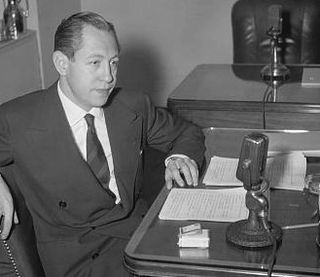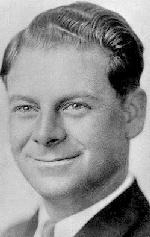Related Research Articles

Burns and Allen were an American comedy duo consisting of George Burns and his wife, Gracie Allen. They worked together as a successful comedy team that entertained vaudeville, film, radio, and television audiences for over forty years.
Texaco Star Theater was an American comedy-variety show, broadcast on radio from 1938 to 1949 and telecast from 1948 to 1956. It was one of the first successful examples of American television broadcasting, remembered as the show that gave Milton Berle the nickname "Mr. Television".

John Florence Sullivan, known professionally as Fred Allen, was an American comedian. His absurdist, topically pointed radio program The Fred Allen Show (1932–1949) made him one of the most popular and forward-looking humorists in the Golden Age of American radio.

William Samuel Paley was an American businessman, primarily involved in the media, and best known as the chief executive who built the Columbia Broadcasting System (CBS) from a small radio network into one of the foremost radio and television network operations in the United States. He was awarded the Carlos Manuel de Cespedes National Order of Merit by the Cuban government in recognition of his efforts to foster greater understanding between the peoples of Cuba and the United States of America.

The Jack Benny Program, starring Jack Benny, is a radio-TV comedy series that ran for more than three decades and is generally regarded as a high-water mark in 20th century American comedy. He played one role throughout his radio and television careers, a caricature of himself as a minimally talented musician and penny pincher who was the butt of all the jokes. Producer Hilliard Marks was the brother of Benny's wife Mary Livingstone.

Parker W. Fennelly was an American character actor who appeared in ten films, numerous television episodes and hundreds of radio programs.

Mr. and Mrs. North are fictional American amateur detectives. Created by Frances and Richard Lockridge, the couple was featured in a series of 26 Mr. and Mrs. North novels, a Broadway play, a motion picture and several radio and television series.
Information Please is an American radio quiz show, created by Dan Golenpaul, which aired on NBC from May 17, 1938, to April 22, 1951. The title was the contemporary phrase used to request from telephone operators what was then called "information" and later called "directory assistance".

Albert Pearce was an American comedian, singer and banjo player who was a popular personality on several radio networks from 1928 to 1947.
The following is the 1950–51 network television schedule for the four major English language commercial broadcast networks in the United States. The schedule covers primetime hours from September 1950 through March 1951. The schedule is followed by a list per network of returning series, new series, and series cancelled after the 1949–50 season. This season became the first in which primetime was entirely covered by the networks. It was also the inaugural season of the Nielsen rating system. Late in the season, the coast-to-coast link was in service.

Blondie is a radio situation comedy adapted from the long-running Blondie comic strip by Chic Young. It stars Arthur Lake as Dagwood Bumstead and, for the majority of its run, Penny Singleton as Blondie Bumstead. The radio program ran on several networks from 1939 to 1950.

The Chase and Sanborn Hour is the umbrella title for a series of American comedy and variety radio shows sponsored by Standard Brands' Chase and Sanborn Coffee, usually airing Sundays on NBC from 8 p.m. to 9 p.m. during the years 1929 to 1948.
Just Plain Bill was a 1932-1955 15-minute American radio drama program heard on CBS Radio and NBC Radio. It was "a story of people just like people we all know.”

Your Family and Mine is an American radio drama series that aired April 25, 1938–April 28, 1939, on NBC, and May 1, 1939–April 26, 1940, on CBS. Sponsored by Sealtest, the 15-minute soap opera program aired weekdays at 5:15 p.m. ET on NBC, and at 2:30 p.m. ET on CBS.
The Standard Vacuum Oil Company was an American joint venture by Standard Oil of New Jersey and Socony-Vacuum Oil established in 1931 to make and market products in the Far East. Around World War I, the market in the Far East was too large to leave unattended, but still small.
The Fred Allen Show is a long-running American radio comedy program starring comedian Fred Allen and his wife Portland Hoffa. Over the course of the program's 17-year run, it was sponsored by Linit Bath Soaps, Hellmann's, Ipana, Sal Hepatica, Texaco and Tenderleaf Tea. The program ended in 1949 under the sponsorship of the Ford Motor Company.
The Pepsodent Show is an American radio comedy program broadcast during the Golden Age of Radio. The program starred comedian Bob Hope and his sidekick Jerry Colonna along with Blanche Stewart and Elvia Allman as high-society crazies Brenda and Cobina as well as a continuously rotating supporting cast and musicians which included, for a time, Judy Garland, Frances Langford and Desi Arnaz and his orchestra.

The March of Time is an American radio news documentary and dramatization series sponsored by Time Inc. and broadcast from 1931 to 1945. Created by broadcasting pioneer Fred Smith and Time magazine executive Roy E. Larsen, the program combined actual news events with reenactments. The "voice" of The March of Time was Westbrook Van Voorhis. The radio series was the basis of the famed March of Time newsreel series shown in movie theaters from 1935 to 1951.

The Dinah Shore Show was a title applied—in some cases specifically and in other cases generically—to several radio musical programs in the United States, some of which had other distinct titles as indicated below. Singer Dinah Shore starred in the programs, some of which were broadcast on the Blue Network, while others were on CBS or NBC.